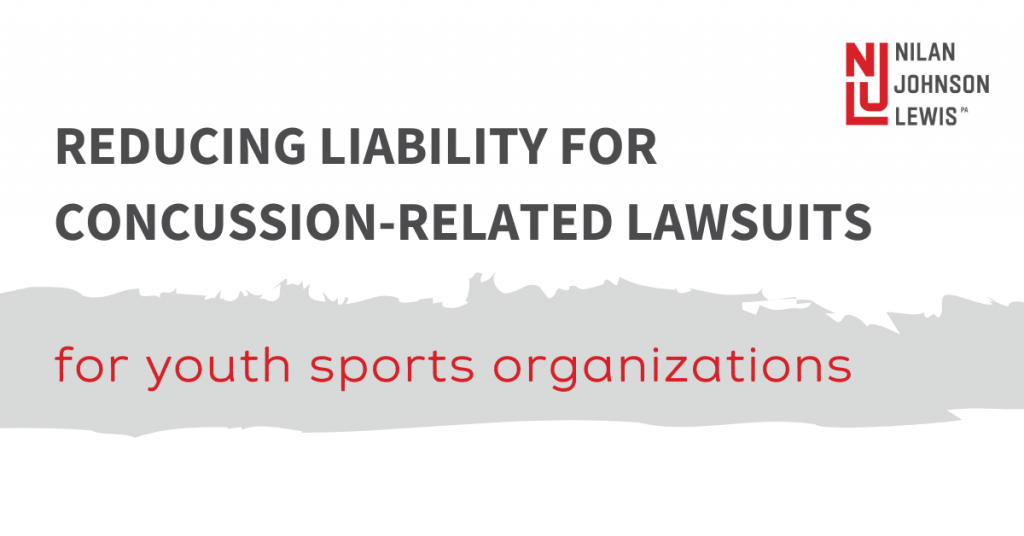
Posted October 13th, 2020 in Top Stories, Legal Insights with Tags Product Liability/Mass Tort
Reducing Liability for Concussion-Related Lawsuits: Document Your Training and Education
Originally published on Sports Engine. Republished here with permission.
Anyone paying attention to the sports world in the past several years is well aware of the spotlight focused on concussions and head trauma. Much of the attention has come from high-profile, class-action lawsuits against major sports leagues like the NFL, NHL, and NCAA. But as these cases run their course and the pool of major sports leagues that can be sued dwindles, plaintiffs’ attorneys have turned their attention to other groups that might be held liable for concussion-related injuries, including manufacturers of helmets and other sports equipment, as well as amateur and youth sports leagues.
Organizers of youth sports leagues, camps, and other athletic groups can and should take steps to reduce their potential liability for concussion-related lawsuits. They should think not just in terms of liability for discrete incidents—a single head injury suffered during a game, for example—but in terms of preventing liability for long-term risks of head injuries to participants as a whole. While such a broad view may seem daunting, youth sports organizations can take concrete steps today that may reduce the likelihood of being sued in a concussion-related lawsuit, or mitigate significant liability if they are sued.
The first focus should be training and education. Many organizations are already providing their members and participants with important training and education on concussion-related risks. These efforts are aided by programs that have been established by government organizations such as the CDC, as well as insurers of sports leagues that have a vested interest in reducing the prevalence and risks of head injuries that could lead to costly lawsuits and insurance claims. For instance, the CDC has developed the HEADS UP Concussion in Youth Sports initiative, which provides free information and training about concussions to coaches, parents, and athletes involved in youth sports. Major insurers of youth sports like aHead of the Game from AIG and Play It Safe Concussion Care from Wells Fargo have also created their own initiatives and programs to provide education and risk management to coaches, parents, and athletes. And many youth sports leagues are already required by state laws to comply with certain safety measures that seek to reduce concussions and follow protocols established by these states.
All of these training and education resources are important. But the mere existence of concussion-related education and training materials will only go so far in mitigating legal liability unless an organization can also show that it actually offered and provided such training and education to its members and participants. In the concussion lawsuits against major sports leagues, liability has often focused on the question of “informed consent.” That is, even though professional athletes consented to participate in their sport and knew head injuries were a risk, did their leagues provide (or even hide) information that would have informed them of the true risks of concussions? The lawsuits also focus on the related question: did the league exercise reasonable care with respect to preventing or reducing head injuries? Youth sports organizations must be able to address these questions in any potential lawsuit and should bolster their compliance and documentation practices to do so.
Organizations should focus on documenting and verifying their provision of concussion-related training and education in order to demonstrate that participants are providing informed consent, and to demonstrate that the organization is exercising reasonable care to protect its participants.
Organizations should consider implementing the following measures:
-
Include concussion education information and resources on your organization’s website, and document or archive versions of the website to show how long it has been available.
-
Distribute concussion education materials to athletes and guardians. Retain copies of these materials, as well as copies of any signed informed consent or liability waivers received.
-
Place concussion education posters, fliers, and brochures in your facilities, and document what materials were posted and made available. The CDC and many insurance companies have made available various concussion-related fact sheets and posters that can be used.
-
Document concussion training and education provided to coaches, referees, or other participants. The CDC’s HEADS UP concussion program provides online training courses that allow participants to print out a certificate once training has been completed, which is an easy and free way to document compliance.
-
Require signed acknowledgment by coaches, referees, and parents of any concussion-related protocols or guidance that your organization has established, such as concussion-symptom spotting and reporting, removal from play, and return to play.
Concussion-related lawsuits are not going away and will most likely proliferate as additional information regarding concussions is learned. Youth sports organizations should take steps today to mitigate their risk of liability.